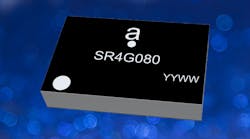This article is part of the TechXchange: Device-Level Antenna Selection Considerations.
Measuring just 9.0 × 5.8 × 1.7 mm, Antenova’s Agosti SR4G080 antenna serves GNSS applications with high-efficiency performance while taking up little space on the corner of printed circuit boards (PCBs). Agosti’s small ground plane and good isolation make it ideal for small wearables, trackers, and on-board diagnostics (OBD) that move around freely.
A key feature of the surface-mounted antenna is its ability to function as well as it does with very little ground-plane area. Typically, surface-mounted antennas use the PCB’s ground plane to radiate signal. Thus, it’s the antenna’s ground-plane requirement that defines the space it needs, not necessarily the physical dimensions of the device itself.
The company’s radiated measurement results show that the Agosti SR4G080 antenna radiates efficiently on small ground planes of 40 × 20 mm, 70 × 25 mm, and 80 × 30 mm, making it a good choice for designs with small form factors.
The device also offers designers some additional layout options, as it's designed to be placed on a corner of their PCB. Agosti is designed to integrate and coexist with other antennas in the same device. OBD and trackers often use 4G/LTE with A-GPS for fallback. The Agosti antenna has been tested with Antenova’s Pharoah SR4L073 antenna, which also has a very small ground-plane requirement. The two antennas maintain excellent isolation and can operate near each other in a very small device without the 4G signal interfering with sensitive GNSS signals.
Small surface-mount antennas such as Agosti are suitable alternatives to the delicate ceramic patch antennas commonly used in GNSS designs. Not only are the surface-mount antennas significantly smaller, but they also provide omnidirectional performance.
Patch antennas are typically 12- or 14-mm square, are heavier than SMD antennas, and need a much larger ground plane and keepout area. They also must be placed in the center of a circuit board and only work well when they point at the sky. Antenova’s new generation of SMD antennas overcome all of these limitations and perform well regardless of position and device orientation.
For more TechXchange articles on this topic CLICK HERE.
To see TechXchange pages on other topics CLICK HERE.
